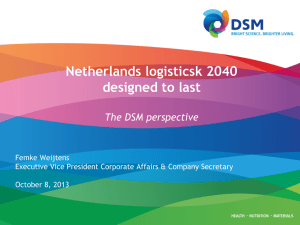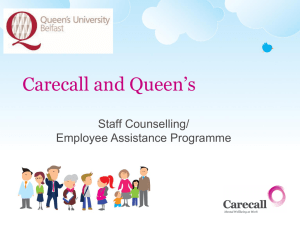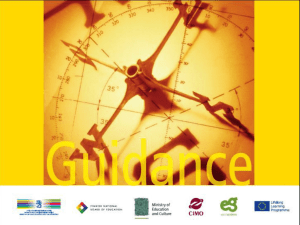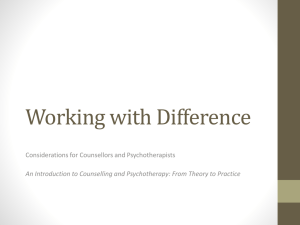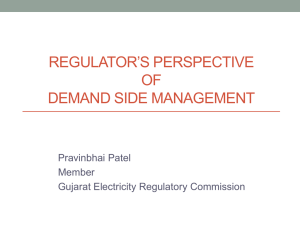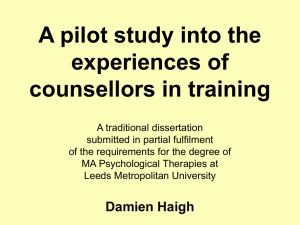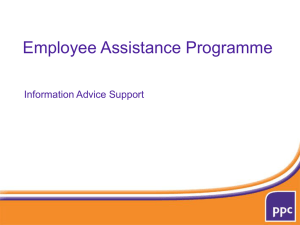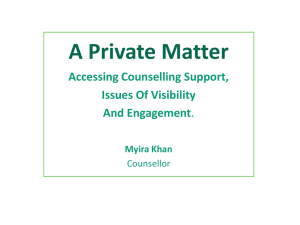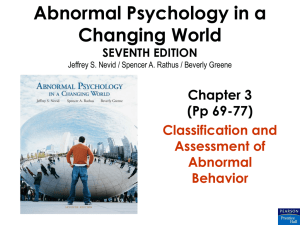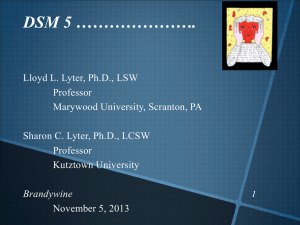Counsellors talk about the DSM
advertisement
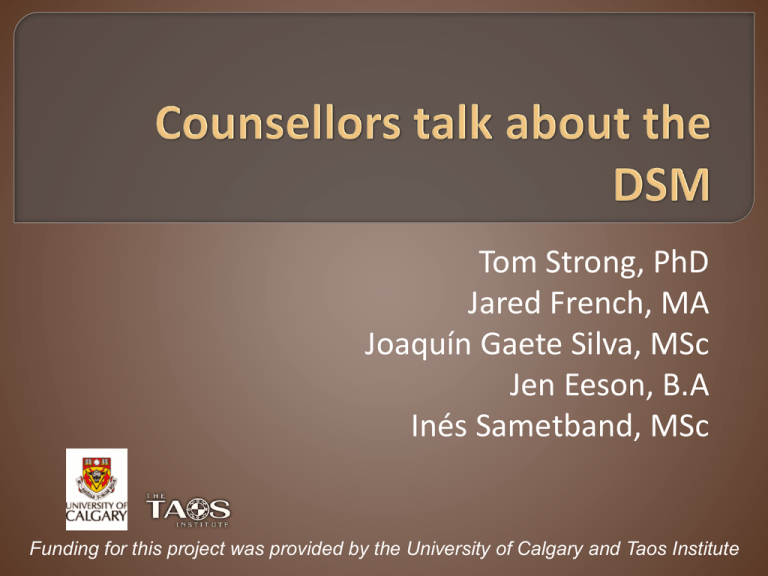
Tom Strong, PhD Jared French, MA Joaquín Gaete Silva, MSc Jen Eeson, B.A Inés Sametband, MSc Funding for this project was provided by the University of Calgary and Taos Institute Why talk to counsellors about the DSM? Our studies and counsellors’ responses to them Making sense of what counsellors told us How the DSM influences counsellors How counsellors respond to the DSM Our thoughts & yours on the DSM Counselling, a multi-theoretical field, has many discourses of practice, each with ways of assessing and naming client concerns DSM is a medically oriented discourse of symptoms though not all client concerns are symptom-based Increasingly, to be paid or work institutionally, counsellors are expected to use the DSM-IV-TR Question: How, if at all, are counsellors influenced by the DSM, and how do they respond to the DSM? To what extent is the DSM a fact in counsellors’ practices? Mental disorders and other ways of formulating clients’ concerns? Some counselling approaches are antithetical to DSM formulations Vico The on linguistic poverty/poetic wisdom world’s 24 hour clock (Geometry?) Modern/postmodern tensions over language and understanding Counselling as conversational work Counselling: single vs diverse discourses? • “Although we assign patients …DSM-IV… diagnoses for record keeping, for the appropriate psychiatric referrals, and for insurance purposes, we have not found that this nosology, or any other “official” diagnostic typology, is of much use in the complex environment of ongoing psychotherapy.” Stricker & Gold, J. (2005) • DSM-IV is a symptom “language tethered to itself”, Gary Greenberg, 2010, p. 79 • “it is my view that DSM5, despite all the debate, remains stubbornly lost in the wilderness”. Allen Frances (Task Force Chair of the DSM-IV) • Language is not innocent – Tom Andersen Common way to diagnose client concerns Enables payment & administration of DSM disorders as treatable health problems Enables research into treatment effectiveness by diagnosed condition Unites counselling with medicine DSM/Counselling Tensions Not all counselling approaches see clients’ concerns as treatable pathologies What about counselling and problem-solving, Skill development, etc? Family systems & social justice concerns? Administrative and frontline needs? Why any single discourse over others? How does expected use of DSM fit with the problem formulation practices of counselling’s diverse approaches? Institutional/official discourses & unofficial / ad hoc dialogues with clients? DSM & the discursive therapies? Overview Funding • University of Calgary, Taos Institute, SSHRC, CIHR Website, survey, phone interviews • Survey questions, phone interview questions Who participated • demographics Current study funded by: • University of Calgary and Taos Institute • Social Sciences and Humanities Research Council • Canadian Institutes of Health Research study Related projects: • Counsellor Education • Understanding and practicing non-psychiatrically oriented counselling Dialogues on DSM website: • www.ucalgary.ca/DDSM • Discussion Forum • Link to the on-line survey • Phone Interviews http://www.ucalgary.ca/ddsm/forum/2 Topic Examples: DSM and other therapeutic discourses Client responses to diagnosis The DSM-IV-TR is not a neutral language of practice Demographic information such as country of practice, primary orientation(s), number of years in practice, education, practice setting Information about expected use of psychiatric discourse (DSM), empirically based practice Long answer questions – how these expectations have influenced preferred orientation to practice and how counsellors creatively deal with these influences Meant to capture how Canadian counsellors are influenced by psychiatric (DSM) discourse Approx 1 hour in length 15 questions, semi-structured Psychiatric Discourse: What aspects of psychiatric discourse are at odds with your orientation to practice? Expected use of psychiatric discourse Trends? How has your practice been affected? Creative ways of practicing/managing tensions Integration Online recruitment via list-serves: • Canadian Psychological Association • Canadian Counselling and Psychotherapy Association • Taos Institute • British Columbia Association of Clinical Counsellors • British Association for Counselling and Psychotherapy Survey - 116 participants completed the online survey Discussion Forum – approx. 10 participants Phone interviews – 10 Canadian counsellors recruited via the online survey 62% from Canada 20% from USA 18% from Mexico, Australia, New Zealand, Britain, Norway and South Africa Orientation to practice 1. 2. 3. 4. Client-centered Cognitive behavioral Narrative Therapy Solution focused therapy 28% - Masters in counselling plus specialized training or supervision 27% - Masters in Counselling 20% - Doctoral degree plus specialized training and supervision 16% - Doctoral degree 9% - Masters in family therapy, social work or clinical psychology 1. 2. 3. 4. 5. Private practice (39%) Educational setting (18%) Public mental health agency (17%) Not-for-profit or community organization (16%) Independent or group practice (10%) Extent to which you’re expected to use psychiatric discourse to meet administrative or fee payer requirements Extent to which you’re expected to use evidence supported interventions to meet administrative or fee payer requirements BC: 8, AB: 1, ON: 1 Range of primary approaches: • Narrative, Client-Centered, Solution-Focused, Existential, Psychodynamic, Cognitive behavioral 0-2years: 1, 2-5years: 2, 5-10years: 1 10+years: 6 1: MSW, 7: MA, 2: PhD Range of primary settings: • Educational, Private Practice, Public Mental Health, Community, Consulting Extent required to use DSM diagnoses: • None: 3, Some: 4, Most: 2, All: 1 Phone interviews were transcribed All of the data from the surveys, transcripts and discussion forum posts were copied and pasted into a word document Traditional Grounded Theory • Adopts a perspective believing that ‘THE THEORY’ is waiting to be uncovered. • Attempts to represent a field or situation using a few codes or themes. • Results are presented as ‘objective’ and ‘rational’ and researchers are thought to be separate from the data. Rather than seeking to obtain ‘THE’ theory within a body of data, SA seeks to emphasize the following in a situation of analysis: • Partialities, Positionalities, Complications, Tenuousness, Irregularities, Contradictions, Heterogeneities, Situatedness, Fragmentation, & Complexities This change in focus partly represents the ‘Postmodern Turn’ that SA includes. A key element of SA is ‘Discourse Analysis’ • Which focuses on how discourses work to influence social practices: This includes data analysis that reflects a concern with “how discourses are produced, how we are constituted through them, and how they are performed”. Other elements include: • Identifying the key human and non-human actants within a situation. • Moving away from the idea of analyzing a specific ‘context’ and adopting the view that all conditions within a situation are ‘in play’. SA is a theory/methods package • The ‘situation’ becomes the ultimate unit of analysis and understanding its elements and their relations are the primary goals. • SA becomes a way of ‘knowing’ and ‘doing’ together Three kinds of maps are used in attempting to capture and analyze the situation of interest: • 1) Situational Maps • 2) Social Worlds/Arenas Maps • 3) Positional Maps Situational Maps: • Layout the the major human, nonhuman, discursive, and other elements in the research situation and provoke analysis of relations among them. • Situational Maps Include: Abstract Situational Maps or “Messy Maps” Ordered Situational Maps Relational Maps Social Worlds/Arenas Maps • The focus is on identifying collective social action and seeing social worlds as ‘Universes of Discourse’. • Researchers ask themselves: “What are the patterns of collective commitment and what are the salient social worlds operating here?” “What constraints, opportunities, and resources do they provide in the social worlds?” Positional Maps • Lay out the major positions taken and not taken in the data. ‘Positions’ are positions of discourses and represent the heterogeneity of positions, not of individuals, groups, or institutions. Clarke states that the three maps are not intended to be formulas for analysis, but rather as directions through which to begin and deepen analytic work as sites for engagement. Multiple ways of responding to tensions: Positions denoting hybridities Positions denoting negotiations Positions denoting preferences The absent but implicit (White, 2000) Being part of the puzzle (biopsycho-social) “So that everyone kind of knows what part of the healing practice are we in with the client, so that we can sort of work together and make it make sense”. Like we all, I think, think that we're all doing the best for the client" (interview). Being proficient "I often have experienced myself "doing" apathetic obedience. I appreciate knowing someone else also has times where this a response that helps us continue in our work" (blog). Being part of collaborative communities "So, you know, in staff meetings or in case consultations with clients present, challenging some of those dominant ideas about symptoms and diagnosis and medication, if that doesn't fit for the clients, and maybe bringing up some of their preferred ways that they may have talked about in the therapy room with me and making sure that that client voice is heard” (interview). Making space for clients’ voices “My listening and ability to hear what others are saying has grown. In the face of horrific interventions following a quick DSM diagnosis, I can focus on creating a respectful space where the clients’ voice is the largest voice in the room. And, from there, co-create a plan with the client” (survey). "Use of collaborative language, e.g., 'This is one way in which we are able to communicate in a consistent way with your insurance company....as we're talking today, and as you've helped to describe, there are many more aspects involved in the anxiety you experience..." In other words, helping the client feel a part of the process" (interview) “I work with clients to choose their own diagnoses.(...) "we can call you a this or a this". I also discuss which diagnoses will be reimbursed for and the possible risks of each diagnosis- ie. no life insurance, dangers of certain diagnoses being used against the client in a job search, custody battle, and so on” (survey). "My beliefs about the DSM often do not fit in within the places I have worked, I have to find a way to practice from a narrative way and still respect the other professionals involved. I have found 'mini' ways in my practice to do this, I am still looking for 'larger' way“. (survey) "I felt like I had to have two like two faces. So, you know, sit in meetings where I felt like the clients taking and being talked about were quite disrespected and then trying to speak up at appropriate times, versus having clients in my office where nobody can see what's going on and trying to be more respectful than the viewpoints that my colleagues had just been talking about". (interview). Anderson, H. (1997). Conversation, language and possibilities. New York: Basic. Caplan, P. J. (1996). They say you’re crazy: How the world’s most powerful psychiatrists decide who’s normal. New York, NY: Da Capo Press. Clarke, A. (2005). Situational analysis. Thousand Oaks, CA: Sage. Cooper, R. (2004). What is wrong with the DSM? History of Psychiatry, 15(1), 5-25. Cushman, P. (1995). Constructing the self, constructing America: A cultural history of psychotherapy. New York, NY: Perseus. Danziger, K. (1997). Naming the mind: How psychology found its language. London: Sage. Eriksen, K., & Kress, V. E. (2005). Beyond the DSM story: Ethical quandaries, challenges, and best practices. Thousand Oaks, CA: Sage Publications, Inc. Greenberg, G. (2010). Manufacturing depression: The secret history of a modern disease. New York: Simon & Schuster. Hacking, I. (1998). Mad travelers: Reflections on the reality of transient mental illness. Cambridge, MA: Harvard University Press. Hallward, P. (2005). The politics of prescription. The South Atlantic Quarterly, 104, 769-789 Hansen, J. T. (2003). Including diagnostic training in counseling curricula: Implications for professional identity development. Counselor Education and Supervision, 43, 96-107. House, R. (2005). Therapy beyond modernity: Deconstructing and transcending profession-centred therapy. London: Karnac. Linell, P. (2009). Rethinking language, mind, and world dialogically. Charlotte, NC: Information Age Publishing Strand, M. (2011). Where do classifications come from? The DSM-III, the transformation of American psychiatry, and the problem of origins in the sociology of knowledge. Theory & Society, 40, 273-313. Strong, T. (2008). Hijacked conversations in counselling? Journal of Critical Psychology, Counselling and Psychotherapy, 8(2), 65-74. Strong, T. (2006). Wordsmithing in counselling? European Journal of Psychotherapy and Counselling, 8, 251-268. Watters, E. (2010). Crazy like us: The globalization of the American psyche. New York: Free Press. Tom Strong Inés Sametband Joaquín Gaete Silva For further information: strongt@ucalgary.ca Jared French Jen Eeson

